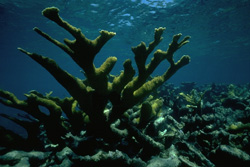 
Chemistry: Matter and ChangeChapter 18:
Chemical EquilibriumProblem of the Week <a onClick="window.open('/olcweb/cgi/pluginpop.cgi?it=gif::::/sites/dl/free/0078664187/179001/ch18_chapter.gif','popWin', 'width=NaN,height=NaN,resizable,scrollbars');" href="#"><img valign="absmiddle" height="16" width="16" border="0" src="/olcweb/styles/shared/linkicons/image.gif"> (0.0K)</a> <a onClick="window.open('/olcweb/cgi/pluginpop.cgi?it=gif::::/sites/dl/free/0078664187/179001/ch18_chapter.gif','popWin', 'width=NaN,height=NaN,resizable,scrollbars');" href="#"><img valign="absmiddle" height="16" width="16" border="0" src="/olcweb/styles/shared/linkicons/image.gif"> (0.0K)</a> | Calcium
Carbonate
Carbon dioxide is removed from the atmosphere
by dissolving in ocean water and forming carbonic acid.
CO2 (g)+ H2O (l) ↔ H2CO3 (aq) (carbonic acid)
Once dissolved into sea water, carbon dioxide is converted into bicarbonate (HCO3-) ions or carbonate (CO3-2) ions.
H2CO3 (aq) ↔ H+ (aq) + HCO3- (aq)
HCO3- (aq) ↔ H+ (aq) + CO3-2 (aq)
Certain forms of sea life biologically fix bicarbonate with calcium (Ca+2) to produce calcium carbonate (CaCO3). Ca+2(aq)+2HCO3-(aq)↔CaCO3(s)+CO2 (g)+ H2O(l) |  <a onClick="window.open('/olcweb/cgi/pluginpop.cgi?it=jpg::::/sites/dl/free/0078664187/179001/ch18_1.jpg','popWin', 'width=NaN,height=NaN,resizable,scrollbars');" href="#"><img valign="absmiddle" height="16" width="16" border="0" src="/olcweb/styles/shared/linkicons/image.gif"> (28.0K)</a> <a onClick="window.open('/olcweb/cgi/pluginpop.cgi?it=jpg::::/sites/dl/free/0078664187/179001/ch18_1.jpg','popWin', 'width=NaN,height=NaN,resizable,scrollbars');" href="#"><img valign="absmiddle" height="16" width="16" border="0" src="/olcweb/styles/shared/linkicons/image.gif"> (28.0K)</a> | Organisms, such as corals, calcareous algae, clams, mussels, cockles and snails, can extract calcium carbonate from sea water to build skeletal structures, and this mineral is deposited as discrete particles when the organism dies.
Pearls are formed when mollusks secrete calcium carbonate in the form of aragonite. After long periods of time, these calcium carbonate deposits are physically and chemically altered into sedimentary rocks known as limestone. Reef growth continuously removes carbon dioxide from the sea water. To maintain equilibrium, sea water is continually refilled by atmospheric carbon dioxide, a process that causes a constant depletion of this greenhouse gas from the atmosphere during times of rapid and widespread reef growth. | The behavior of calcium carbonate (the minerals calcite and aragonite are examples) in a near-surface environment is controlled primarily by equilibrium in the reaction:
CaCO3(s) + H2CO3(aq) ↔ Ca+2(aq) + 2HCO-3 (aq)
When H2CO3, carbonic acid, is formed in rainwater by the reaction between water and carbon dioxide: H2O (l) + CO2 (g) ↔ H2CO3 (aq), the rain water percolates through the ground until it reaches limestone formations. Limestone is dissolved by carbonic acid and caves are created. When the resulting calcium bicarbonate solution is exposed to air, the dissolved CO2 is released into the atmosphere and calcium carbonate precipitates out forming stalactites. Stalactites grow at the rate of about 1-inch per century. | Large limestone formations like the stone forest near Kunming, China are weathered by the carbonic acid in rainwater. Carbonic acid is used to weather rocks, yielding bicarbonate ions.
H2CO3 (aq) + CaCO3 (s) ↔ 2HCO3- (aq) + Ca++(aq)These chemical equilibrium systems are dynamic. If the equilibrium is disturbed the reaction will favor either the forward or reverse reaction. Temperature
Carbon dioxide is more soluble in cold water while calcium carbonate precipitates in hot water and is often found near hot springs. Changes in Pressure
According to Henry's Law, an increase in pressure increases the solubility of gases in liquids. The increase in carbonic acid dissolves calcium carbonate. Organic Activity
Green plants remove carbon dioxide in the process of photosynthesis, while decaying plants release carbon dioxide. Changes in the amount of carbon dioxide results in the precipitation of calcium carbonate, less CO2, or the solubility of calcium carbonate, more CO2. The "Acidity" of the Environment
The H+ ion is a measure of the "acidity" of a solution. As the pH of a solution decreases there is an increase in H+ ions. Ocean water has a pH of about 8, a weak base, while rainwater has a pH of about 6, a weak acid. Calcium carbonate dissolves in an acid solution and precipitates in a basic solution. (basic) CaCO3 + H2CO3 ↔ Ca+2 + 2HCO-3 (acidic) |  <a onClick="window.open('/olcweb/cgi/pluginpop.cgi?it=gif::::/sites/dl/free/0078664187/179001/POWproblem_1.gif','popWin', 'width=NaN,height=NaN,resizable,scrollbars');" href="#"><img valign="absmiddle" height="16" width="16" border="0" src="/olcweb/styles/shared/linkicons/image.gif"> (0.0K)</a> <a onClick="window.open('/olcweb/cgi/pluginpop.cgi?it=gif::::/sites/dl/free/0078664187/179001/POWproblem_1.gif','popWin', 'width=NaN,height=NaN,resizable,scrollbars');" href="#"><img valign="absmiddle" height="16" width="16" border="0" src="/olcweb/styles/shared/linkicons/image.gif"> (0.0K)</a> | Write
the equilibrium constant expression for the reactions below
that are involved in the formation of calcium carbonate.
1. CO2 (g)+ H2O (l) ↔ H2CO3 (aq)
2. H2CO3 (aq) ↔ H+ (aq) + HCO3- (aq)
3. Ca+2(aq)+2HCO3-(aq)↔ CaCO3(s) + CO2 (g)+ H2O(l)
4. CaCO3(s) + H2CO3(aq) ↔ Ca+2(aq) + 2HCO-3 (aq)
| |
|  <a onClick="window.open('/olcweb/cgi/pluginpop.cgi?it=gif::::/sites/dl/free/0078664187/179001/POWproblem_2.gif','popWin', 'width=NaN,height=NaN,resizable,scrollbars');" href="#"><img valign="absmiddle" height="16" width="16" border="0" src="/olcweb/styles/shared/linkicons/image.gif"> (0.0K)</a> <a onClick="window.open('/olcweb/cgi/pluginpop.cgi?it=gif::::/sites/dl/free/0078664187/179001/POWproblem_2.gif','popWin', 'width=NaN,height=NaN,resizable,scrollbars');" href="#"><img valign="absmiddle" height="16" width="16" border="0" src="/olcweb/styles/shared/linkicons/image.gif"> (0.0K)</a> |
What information must you collect to determine the equilibrium
constant of reaction 3 above. | | | | |  <a onClick="window.open('/olcweb/cgi/pluginpop.cgi?it=gif::::/sites/dl/free/0078664187/179001/POWproblem_3.gif','popWin', 'width=NaN,height=NaN,resizable,scrollbars');" href="#"><img valign="absmiddle" height="16" width="16" border="0" src="/olcweb/styles/shared/linkicons/image.gif"> (0.0K)</a> <a onClick="window.open('/olcweb/cgi/pluginpop.cgi?it=gif::::/sites/dl/free/0078664187/179001/POWproblem_3.gif','popWin', 'width=NaN,height=NaN,resizable,scrollbars');" href="#"><img valign="absmiddle" height="16" width="16" border="0" src="/olcweb/styles/shared/linkicons/image.gif"> (0.0K)</a> | CaCO3(s) ↔ Ca+2(aq) + CO3-2
(aq)
Calcite and aragonite
are both forms of calcium carbonate but have very different
crystalline structures. Calcite, formed form coral, has a Ksp
of 4.5 x 10-9, while aragonite, found in pearls, has a Ksp of
6.0 x 10-9. Which of these two forms of calcium carbonate is
the most soluble at 298 K? For each of the forms of calcium
carbonate, calculate the solubility. | | |  <a onClick="window.open('/olcweb/cgi/pluginpop.cgi?it=gif::::/sites/dl/free/0078664187/179001/POWproblem_4.gif','popWin', 'width=NaN,height=NaN,resizable,scrollbars');" href="#"><img valign="absmiddle" height="16" width="16" border="0" src="/olcweb/styles/shared/linkicons/image.gif"> (0.0K)</a> <a onClick="window.open('/olcweb/cgi/pluginpop.cgi?it=gif::::/sites/dl/free/0078664187/179001/POWproblem_4.gif','popWin', 'width=NaN,height=NaN,resizable,scrollbars');" href="#"><img valign="absmiddle" height="16" width="16" border="0" src="/olcweb/styles/shared/linkicons/image.gif"> (0.0K)</a> |
Snail shells are composed of calcium carbonate and they live
at all ocean depths. Hydrothermal vents are located on the ocean
floor and the sea water near vents are very acidic. Snails located
near hydrothermal vents are "naked." Explain this
observation. |  <a onClick="window.open('/olcweb/cgi/pluginpop.cgi?it=gif::::/sites/dl/free/0078664187/179001/webLinks.gif','popWin', 'width=NaN,height=NaN,resizable,scrollbars');" href="#"><img valign="absmiddle" height="16" width="16" border="0" src="/olcweb/styles/shared/linkicons/image.gif"> (1.0K)</a> <a onClick="window.open('/olcweb/cgi/pluginpop.cgi?it=gif::::/sites/dl/free/0078664187/179001/webLinks.gif','popWin', 'width=NaN,height=NaN,resizable,scrollbars');" href="#"><img valign="absmiddle" height="16" width="16" border="0" src="/olcweb/styles/shared/linkicons/image.gif"> (1.0K)</a> | Useful Web Sites:
Jurrasic Reef Park
ThinkQuest Library of Entries - Coral Realm
Aragonite and The Carbon Cycle
LeChâtelier Principle
Chemical of the Week - Carbon Dioxide | |
 |  |
|





